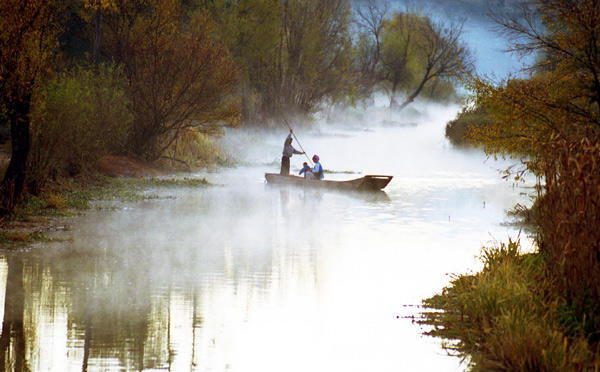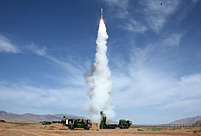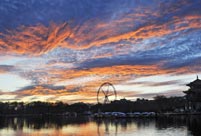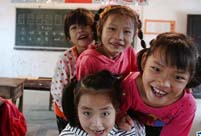 |
| (Provided to People's Daily Online/Yang Jiayao) |
Suggested itinerary: seven days and six nights
1st day: arrive at Kunming; 2nd day: visit Kunming; 3rd - 4th day: Dali; fifth to sixth day: Lijiang; 7th day: leave from Lijiang
Kunming
Kunming, capital of Yunnan Province, is known as "the City of Eternal Spring" for its pleasant climate and flowers blooming all year long. It is the only place in the world where you can find eternal spring.
Fisherman’s songs have lasted for a thousand year on the Mother Lake of the Dian Lake. The sleeping beauty of Western Hills immerses herself in her own world.
(Notes:In the western suburbs of Kunming lies Western Hills. They are also called "sleeping Buddha Hills". For looked at from a distance, they have the appearance of a giant sleeping Buddha. They have also been given another name - "leeping Beauty Hills" for the hills when viewed together look like a beautiful young lady laying beside Dianchi Lake with her face upward and her hair trailling into water.)
Black-headed gulls fly thousands of miles from Siberia to Kunming to live through the winter, every year from November to the following March.
The melody of bell still lingers on the biggest bronze-tiled temple in the world, the ashram where the well-known beauty Chen Yuanyuan lived.
(Notes: Chen Yuanyuan was one of the Eight Beauties of Qinhuai. Chen Yuanyuan, originally named Xing Yuan, was a well-known beauty of Suzhou in the late Ming and early Qing Dynasty. She was a good singer and dancer. At first she was a singsong girl of Tian Wan, and then married to Wu Sangui as his concubine. When Li Zicheng's peasant rebel army captured Beijing, his subordinate named Liu Zongmin ravished Chen Yuanyuan. Later Wu Sangui surrendered to the Qing Army, who then captured Beijing. Chen Yuanyuan came back to Wu Sangui again. In her late years Chen Yuanyuan became a Taoist nun who then renamed herself Jijing, style name Yu'an. Golden Temple Park, or Jindian Park, is the largest Taoist Tongwa (bronze-tiled) temple in China and has been preserved almost completely since it was first built.At the top of the mountain behind the temple hangs a 14-ton "Great Bell of the Ming Yongle Era".)
Villages of 26 minorities with original beauty are located in the Yunnan Ethnic Minorities’ Village.
Have a football match or enjoy some local stories in the Haigeng Park.
Ride the ferris wheel in the Grandview Park, talk a walk on the Nanping Street or chat with foreign friends in the Cultural Alley. Please stay, dear guests from afar, please stay in the eternal spring.
(Notes: Grandview Park, aiso named as Daguan Park in Chinese, is located at the terminus of Daguan Road and is 6 km from the city center, near Dianchi Lake and facing Taihua Mountain which is on the other side of Dianchi Lake.
The Park Scenic Area includes the three-storied Grand View Pavilion, which provides a spectacular view across sparkling Dianchi Lake to the distant Western Hills, and some winding corridors, bonsais, rockeries, trees and porches, willowed causeways, arch bridges, and archways centering around.
Nanping Street is the history of the Old Street area of Kunming.)
Dali
Dali is the most romantic place in the world. In the aroma of Buddha, with Erhai Lake to the east, and Cangshan Mountain to the west, Dali exudes mystery.
A total of nine kings of Dali Kingdom abandoned worldly life and studied Buddhism at Chongsheng Temple
(Notes: It was a famous royal monastery for the consecutive Nanzhao Kingdom and Dali Kingdom. A total of nine kings of Dali Kingdom abandoned worldly life and studied Buddhism here.)
Mt. Cangshan consists of 19 peaks, in between every two peaks are streams; all the 19 streams are clear and limpid.
(Notes: Mt. Cangshan is made of 19 peaks and make up the highest peaks of the Yunling Mountain Range. In between every two peaks are streams, and water rushes down the mountain and pours into Erhai Lake. These streams originate from spring water or thawing snow and irrigate the farmlands around.)
Every spring, thousands of butterflies fly around the Butterfly Spring, girls and boys sing happily together.
Bai People entertain their guests by serving Three Course Tea: bitter tea, sweet tea and aftertaste. Philosophy lies in tea drinking. Silverware has been produced in Xinhua village since Tang Dynasty. Bai people have led a poetic life for many years.
(Bai People live in DaiLi in YunNan Province. Like many other ethnic groups in Yunnan, the Bai people love tea. They even put their philosophy thinking in the tea ceremony, which is called the Three-brew tea ceremony.
The first brew is called "bitter tea". The tea maker bakes some tea in a pot on the fire, then puts hot water inside, and gives the tea to the drinker. This brew has a burning smell and is very strong and bitter.
The second brew is called the "sweet tea". The tea maker uses the same material and procedure to make another fresh tea soup, but adds some brown sugar at last. This brew has an attractive sweet taste.
The last brew is called aftertaste. The tea maker usually adds some flavors such as honey, pop rice, pepper, and walnut. This brew has all flavors blended together and is rich of aftertaste.)
Xinhua Village, Land of Silverware and Waters
Dali, an attractive city where you can feel romance.
Lijiang
Lijiang is a beautiful city in Yunnan. In the old town of Lijiang, streets lie along the river, roads are paved with green slabstones, Naxi women wear colorful clothes, and elder people play ancient court music and Naxi ancient music.
Ride along in the Shuhe ancient town of the old tea-trading route.
(Notes: Shuhe or "Shaowu" in the Naxi language, means the village at the foot of the high hill. It is also called Dragon Spring Village after a spring that rises nearby.
Nestled at the foot of Jade Dragon Snow Mountain, 6 km northwest of Lijiang old town, Shuhe was once a staging post at ancient Tea & Horse Road. In history, with the rise of Tea & Horse Road, Shuhe town was a major producer of leatherworking in the region.)
Does the third country of Jade Dragon from the Dongba hieroglyph really exist on the Jade Dragon Mountain? Where does the god of mountain Sanduo lives?
(Notes: Looking from Lijiang Old Town in the south which is 15 kilometers (nine miles) away, the snow-covered and fog-enlaced mountain resembles a jade dragon lying in the clouds, hence the name. The mountain is a holy mountain for the Naxi (also spelt Nakhi and Nahi) people, a soul of the tribe. Allegedly, the Naxi tribe believed that their Genius "Sanduo" was the god of mountain, living on the Jade Dragon Mountain.
The spruce level ground is 3365 meters above the sea level. In Naxi language, it is "Wuluyoucuige", which means "the place to die for love in the Jade Dragon Mountain". In Naxi legends, the young men and women in "The third country of Jade Dragon" who wanted to die for love would go there.)
Dongba hieroglyph, created by Naxi People, is the only one hieroglyph which is still alive in the world.
Shangri-La
Scared Snow Mountain, deep gorges, cascading waterfalls, tranquil lakes surrounded by forests, crowds of cattle lingering on the beautiful prairie, sky that as clean as a mirror and magnificent temples. This is how Shangri-La looks like in James Hilton’s novel Lost Horizon.
(Notes: Shangri-La is the "Eden in dream". Since it first appeared in British novelist James Hilton's Lost Horizon in the 1939, it has been associated with the mystique of a place which could not possibly exist here on Earth.)
Tibetan people in Shangri-La drink Tibetan beer and butter tea, they do Xuanzi dancing, horse racing and host worship ceremony. They present hada scarves to their honored guests.
(Notes: Sometimes called "Tibetan Beer", Barley Wine is a favorite of Tibetans and a necessary part of festivals, marriage feasts, and other important occasions.
Butter tea is a traditional Tibetan drink. It is an everyday drink, but is also used for entertaining guests. Butter tea is very nutritious and suited to the cold, high-altitude region. It keeps the body warm and the blood circulating, while quenching thirst and overcoming fatigue. It 's the Tibetan 's all-in-one energy drink.
On May 5 of the lunar calendar, the Tibetans in the Zhongdian Autonomous County, which now has been called "Shangri-La", hold a pageant horse racing competition, which is considered as the most animated among the annual festivals in the plateau.
Xuanzi Dancing means Guoxie (dancing in circle) in Tibetan. It is basic dancing in the life of Tibetan people. So-called "Xuanzi" is the dance accompanied with horsetail huqin. There is no fixed site for Xuanzi dancing. People of all ages and genders can take part in it. Whenever there are festivals, celebrations and important get-togethers, people will come together for the dancing. Men play the string instrument and women make sleeve dance. They group on opposite sides, hold hands to form a circle. One lead the chorus and the other recite. Then they exchange the roles.
Presenting Kata Scarves is a common practice among the Tibetan people to express their best wishes on many occasions such as wedding ceremonies, festivals, visiting elders, and entertaining guests. The white Kata, a long narrow scarf made of silk, embodies friendship, purity, goodwill, good fortune, harmony and love. )
The world famous Shangri-la is the sun and moon in heart.
(Notes: In Tibetan,Shangri-La means the "sun and moon in heart", an ideal home only found in heaven.There the lofty and continuous snowy mountains, endless grasslands, steep and grand gorges, azure lakes and the bucolic villages always leave a deep impression on visitors.)
 National Plug In Day celebrated in Washington D.C.
National Plug In Day celebrated in Washington D.C. New model of indigenous surface-to-air missiles testfired
New model of indigenous surface-to-air missiles testfired  118.28-carat diamond to be auctioned in HK
118.28-carat diamond to be auctioned in HK Maternal love under streetlight
Maternal love under streetlight Naked foreign student sits in the middle of a road in Haikou
Naked foreign student sits in the middle of a road in Haikou  Colorful Yunnan: Enjoy the natural beauty
Colorful Yunnan: Enjoy the natural beauty Harbin named Chinese city with most beautiful women
Harbin named Chinese city with most beautiful women For last four students, teacher couple sticks to post on island
For last four students, teacher couple sticks to post on island  When big sport stars were kids
When big sport stars were kids PLA's 38th Group Army conduct training
PLA's 38th Group Army conduct training People mourn for victims of mall attack
People mourn for victims of mall attack The last days of Wan Aihua
The last days of Wan Aihua Highlights at 12th National Games of China
Highlights at 12th National Games of China Beijing Film Academy welcomes freshmen
Beijing Film Academy welcomes freshmen Large mahjong party sets new world record
Large mahjong party sets new world recordDay|Week|Month